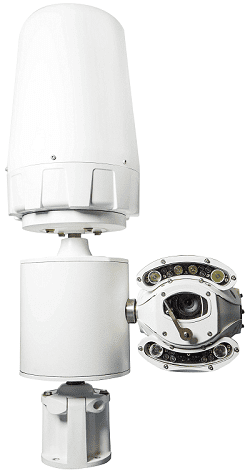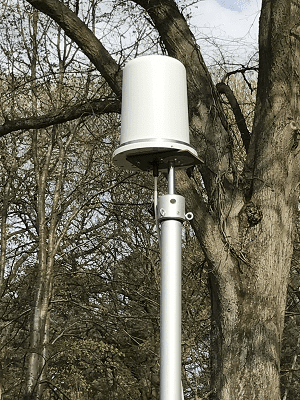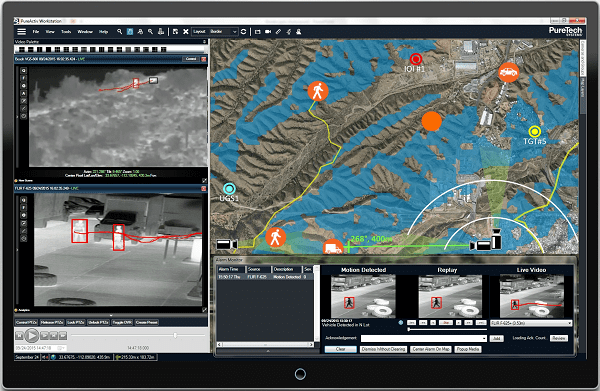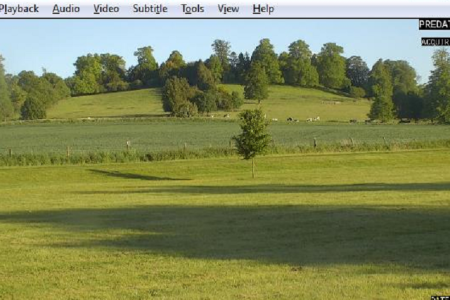CCTV + radar vs. CCTV + analytics – choices, choices
Mark Fletcher looks at the technology combination of radar and CCTV cameras to see how they can exploit each other’s capabilities to create more effective monitoring solutions. I start with a new partnership between 360 Vision Technology and Navtech Radar and then invite comment from other suppliers.
With IP-based and cross-platform-integration-capable security solutions becoming the norm in the security market, it makes sense that different systems should trade off the strengths of each other to create more powerful end packages.
Recently we have seen this with access control systems being tied to cameras and even HVAC systems, but one of the other logical combinations is radar and CCTV. In this instance the radar is used to detect a target, before triggering a camera to start recording. Not only does this provide a targeted approach to identification, but it also negates the need for cameras to run 24/7 – cutting down storage and analysis time and cost.
360 Vision Technology has recently announced a partnership with Navtech Radar to do just this –- create effective surveillance camera solutions for wide area security monitoring and intruder detection.
With conventional movement sensors and object detectors, such as fence-line systems, a light has to enter a detector unit or a beam blocked for the sensor to register activity and alert an operator. In real-world applications, many variables can block or disrupt this. Sensors and detectors are a passive technology – waiting to be triggered, whereas radar is an active technology, which emits a signal at regular intervals. Unlike passive solutions, radar is always asking the question ‘What’s out there?’
Radar can track multiple objects too, up to forty in the case of 360 Vision Technology’s Predator radar ‘all-in-one’ wide area PTZ camera. Its sophisticated on-board software will identify target objects and continue to track them until they leave the monitored area (or beyond if required). This helps CCTV operators to be alerted to a situation, and identify where and what the object is – greatly reducing false alarm rates compared to passive detectors that only know that something is in the area – not it’s path or identity.

Radar vs. analytics
360 Vision Technology explains that, radar, versus analytics, has the advantage of gathering information from a three-dimensional map of any scene, and giving an accurate bearing to within 17cm, even at an extended range. Analytics-based systems need to make important alarm decisions on information deduced from a two dimensional screen and individual pixels, so therefore cannot be as accurate at identifying objects and tracking their movements throughout a monitored area. This means analytics-based tracking systems may alert an operator to movement or intrusion that is subsequently determined to be a false alarm by the operator – which again, results in increasing overall workload in the control room.
The company goes on to explain that video camera prices are often directly compared to the cost of radar alternatives, but it is important to consider the total cost of installing and then maintaining a system. Radar units cover a minimum distance of 300m, and can be spread out accordingly. Video analytics-based cameras typically require a spacing of between 60 to 80m, depending on the type of technology and implementation approach – this means that five times more video cameras are required compared to radar systems, to provide the same area coverage.
This has a direct impact on infrastructure and installation cost – meaning a radar system requires less cabling, less power, less communication equipment and less manpower to install. Therefore, the total cost of installation is far lower for a radar system compared to a typical camera system.
Video-based systems require careful control of the ambient environmental conditions to control the false alarm rate. These conditions are severely disrupted in the case of an on-site non-security procedure or incident and can perform poorly in adverse and changing weather conditions – greatly increasing the false alarm rate. The ability of the radar system to perform in smoke, fire, fog, and even extreme weather such as sandstorms means that detect and follow functionality and reliability remains unaffected – no matter what the environmental conditions. This reduced false alarm rate ensures increased operator confidence and reduces the fatigue generated by the need to investigate high levels of false alarms. Confidence in a radar-based system ensures operators remain fresh and alert, with the ability to respond quickly to genuine alarms.
With some strong claims being made here, in particular its claimed strengths versus analytics, it is only fair to let other suppliers voice their opinions, but first I spoke to Ogier Electronics Sales and Marketing Director, Mark Rainbow: “Ogier Electronics and 360 Vision Technology have also combined their technology to offer an integrated solution,” he explains. “It provides a platform which is easy to install and set-up and a gives a clear 360° line of sight for the radar. I believe that the radar technology can be used as a medium- to long-range sensor for the initial detection and once the camera is locked on the person or vehicle, on-board analytics could take over the tracking. Therefore both technologies bring a benefit to the solution.

“Ogier has designed a range of radar sensors,” he continues, “from our flagship Scan-360 IP to a fence-line beam and a static radar, offering 360° detection over 200 or 500m along a fence line. All of our products have an IP interface and integration to leading VMS platforms. The radars have an intuitive web-page-based set-up allowing simple set-up of the detection perimeter and terrain using maps, set-up of various alarm options, time scheduling, filters, logs, etc. The software also has a live view which also indicates targets in real-time.”
Regarding technological collaboration, he explains: “CCTV systems have to become more self-aware and intelligent, relying less on human monitoring to make them more effective and cost-effective to survive in the climate we have today. I see a collaboration of many different technologies which will all be incorporated into a new breed of camera platform. The traditional PIR sensors, although having a shorter range, higher false-alarm rate and reduced sector coverage are cheaper. Radar offers a simple install versus the installation of multiple sensors and fixed cameras, but the cost difference and possibly skill set is the big issue”.
“It’s a relatively new technology,” he explains, “especially for general CCTV perimeter protection applications against a very strong traditional sensor market place, therefore we need to engage with customers and educate them of the benefits of using radar sensors with PTZ cameras, which should allow the market to grow. This will organically generate the development of new features and integrations the next generation of CCTV solutions will require.”
Eric Olson, Marketing Vice President at PureTech Systems also adds his thoughts and suggests some counter arguments to 360 Vision Technology’s claims: “Many intelligent video systems today, including ours, use ‘geospatial video analytics’, meaning that the video analytics software understands how every video pixel relates to a specific geographic location (latitude, longitude and elevation). This essentially turns a camera into an intelligent video radar. So, in addition to providing radar-type positional data (latitude, longitude, elevation, real size, real speed, real acceleration) it also provides robust video information (still image, video clips, target classification – human, animal, car, colour information, behaviours, scene information, etc.).

“Radar is indeed a great long-range detector,” he continues, “but we don’t agree with the comments about video limitations. Cameras enabled with geospatial video analytics are currently deployed in [environmentally sensitive] areas such as the southern U.S border. They are detecting, tracking and auto following targets at distances of five miles and beyond. The company also implies that cameras are heavily impaired by environmental conditions. This may be true with some visible cameras, but thermal cameras, which are a popular choice for critical facilities, can easily detect intruders and other potential hazards in most weather conditions, even total darkness, camouflaging foliage, smoke, dust, and light fog.”
He also believes that a single, all-in-one system can be restrictive. “Specific applications may be served better with a different radar type (over-land versus over-water). Likewise, video verification is also potentially limited. Facilities may require video verification at very long distances (five or more miles), requiring higher performing cameras, others may want a high resolution visible camera, and others may require a very responsive PTZ to auto track fast moving targets. It can be difficult for an all-in-one system to meet the wide range of scenarios encountered by critical facilities. Additionally, the optimal location of the radar is often not the optimal location for the camera. Likewise, a single camera view may be limiting. The ability to swing several available cameras to the radar locations can provide more information about the target and reduce the issue of obstructions.”
“There are many exciting developments in the use of intelligent video,” he continues. “In the area of video and radar surveillance, several developments, including the ability to combine video and radar alarm information, as well as the ability to merge information from multiple sensors, including video, radar, GPS and AIS. Additionally, the reduced cost of CPU power and the ability to gain this power in a very small footprint has also allowed both these technologies (video and radar) to be more affordable to non-critical facilities and applicable to a wider range of applications, such as vehicles, airborne, and the body-worn consumer market, etc.
“Our solution,” he adds, “is very similar, but is deployed as a federated system, providing the user with the ability to choose specific sensors (radar type, camera type) and expand the coverage as desired with multiple cameras and/or multiple radars. In addition to radar detection, video detection and slew-to-radar capability, our system also includes a robust set of metadata derived from video (image, video, colour, behaviour information, size, classification, speed, acceleration, exact location) and from radar that can be utilized in real-time, alarming and forensic efforts. Some of the big issues facing the market today are how to effectively deal with large amounts of sensor data. It calls for making sensors “smart” and automating response actions to help reduce operator workload and allowing them to be more informed and react quicker.”
Bill Flind, Chief Executive of Ipsotek Ltd also adds his thoughts regarding radar versus video analytics, including the false alarm rates. “Ipsotek’s advanced scenario-based video analytics provides the highest level of performance and range (up to 700m using thermal cameras),” he explains. “This is because VISuite allows the definition of unique scenario-based rules which are used to filter out noise and alarm only on user-defined objects. For example, rules can be configured to detect a person travelling a certain path from an outer perimeter to an inner perimeter in a busy airport. A radar system does not allow operators to specify object trajectory or object size, and therefore it is likely to raise false alarms. Additionally, radar is designed for use in sterile environments only, whilst VISuite is designed for use in both sterile and busy pedestrian environments. This is because radar signal bleeds across multiple pixels and thus it can be difficult to identify the exact location of the detected object.
![]()
“Video analytics has seen very large investment from companies,” Flind adds, “however this has focussed mostly on the lower end and on unproven cognitive-only solutions. Ipsotek has developed and deployed GPS mapping and PTZ tracking solutions for high-security perimeters, which provide the same functionality as radar but with reduced false alarm rates, the ability to use existing cameras, and higher levels of functionality.
“Currently the market is saturated with cheap systems,” Flind concludes, “which are over-promising and under-delivering using traditional video analytics. This can cause a lack of confidence in the market, which leads customers to opt for more expensive but proven technologies such as radar. Ipsotek offers an alternative to these systems and has established itself as a global leader in scenario-based Video Analytics. This flavour of video analytics is designed to focus on specific behaviour and therefore increase true detection rate and reduce false alarms. VISuite can be further augmented when used in parallel with systems such as radar or PIDS (ground-buried or fence-mounted) systems.”
This was always going to set the cat amongst the pigeons… allowing suppliers to critique another’s technology in an open forum. There were many more arguments and counter arguments from these companies, but what is apparent is that there is some fantastic technology out there, either on its own or in combination. Like all selection decisions, you need to assess your location, your precise needs, the type of data you wish to see, the accuracy, the resolution; the range… the list goes on. With such a broad spread of concepts, chances are you will find one that very closely matches your needs, and your budget.
[su_button url=”https://www.securitynewsdesk.com/newspaper/” target=”blank” style=”flat” background=”#df2027″ color=”#ffffff” size=”10″ radius=”20″ icon=”icon: arrow-circle-right”]Click here for more from Security News Desk Newspaper[/su_button]













